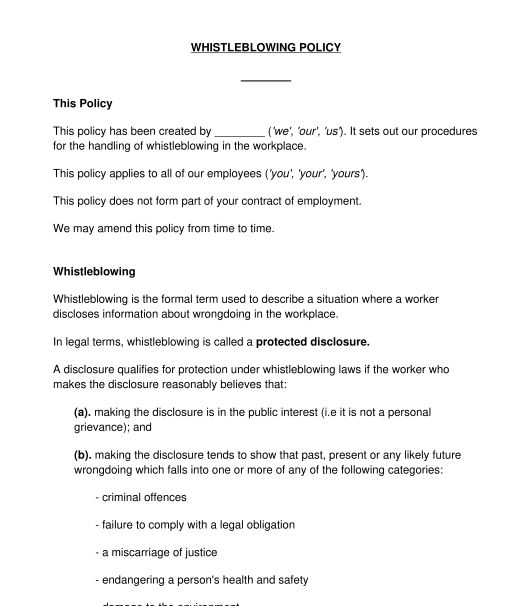 23/09/2025
23/09/2025

Answer a few questions and your document is created automatically.

Your document is ready! You will receive it in Word and PDF formats. You will be able to modify it.

 23/09/2025
23/09/2025
 Word and PDF
Word and PDF
 4 to 6 pages
4 to 6 pages
The policy sets out the procedure of the organisation for dealing with whistleblowing in the workplace.
This document is a policy document that can be used by an organisation that employs and engages staff members in Great Britain. This policy is designed for use in a broad range of organisations. It should be noted however that there are more specific provisions that apply to whistleblowing in certain entities. For example, organisations which are regulated by the Financial Conduct Agency have additional whistleblowing rules which must be adhered to.
Whistleblowing is the term used to describe the situation when a worker shares information about wrongdoing or malpractice in the workplace. Whistleblowing relates to a situation where the wrongdoing affects other people. A member of staff will be protected under whistleblowing laws where they make a disclosure which they believe is in the public interest which could show past, present, or likely future wrongdoing amounting to any of the following:
The law in Great Britain provides workers with legal protection in relation to whistleblowing, provided that this is done in the correct manner. The legal protection ensures that workers are not subjected to detriment or victimisation for whistleblowing. The whistleblowing protection applies to a wide range of different types of workers. It is possible to read more about this on the Protect website.
Personal grievances are not covered by whistleblowing laws. Personal grievances might include things such as bullying, harassment, and discrimination. An employer should hold a separate policy to deal with personal grievances.
The policy will therefore refer to other relevant policies belonging to the organisation such as:
This document should be completed with the relevant information for the organisation.
If the organisation formally recognises a trade union in relation to its staff members, it may wish to consult with the trade union about the policy. Sometimes, the terms of a collective agreement may require that a trade union or works council should be consulted in respect of any policy.
The policy is not a contractual document and does not need to be signed by a representative of the organisation.
Once the policy has been finalised, the workforce should be made aware of its existence. It should be kept in a place which is easily accessible to workers. Typically this might be in a staff handbook or a staff intranet portal.
The Employment Rights Act 1996 (as amended by the Public Interest Disclosure Act 1998 and the Enterprise and Regulatory Reform Act 2016) is the relevant piece of law that protects workers in relation to whistleblowing.
The government has published whistleblowing guidance for employers and a code of practice. The guidance provides useful information and states that it is best practice for an employer to have a written whistleblowing policy or written procedures in place.
You fill out a form. The document is created before your eyes as you respond to the questions.
At the end, you receive it in Word and PDF formats. You can modify it and reuse it.
A guide to help you: Differences between an Employment Contract, Service Contract and Consulting Agreement
Employer Whistleblowing Policy - Sample, template
Country: United Kingdom